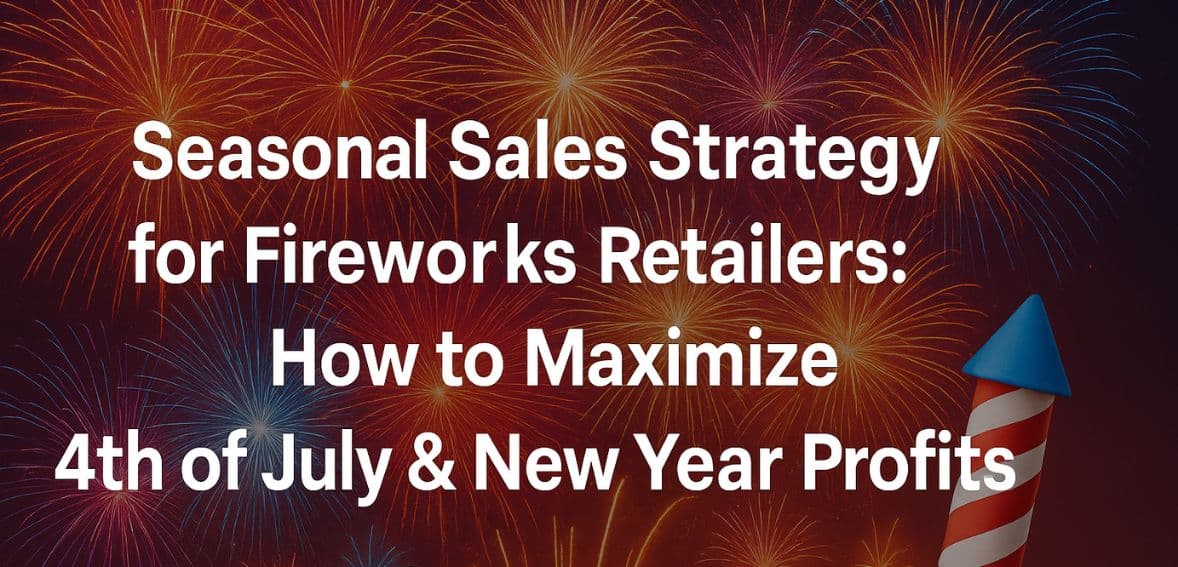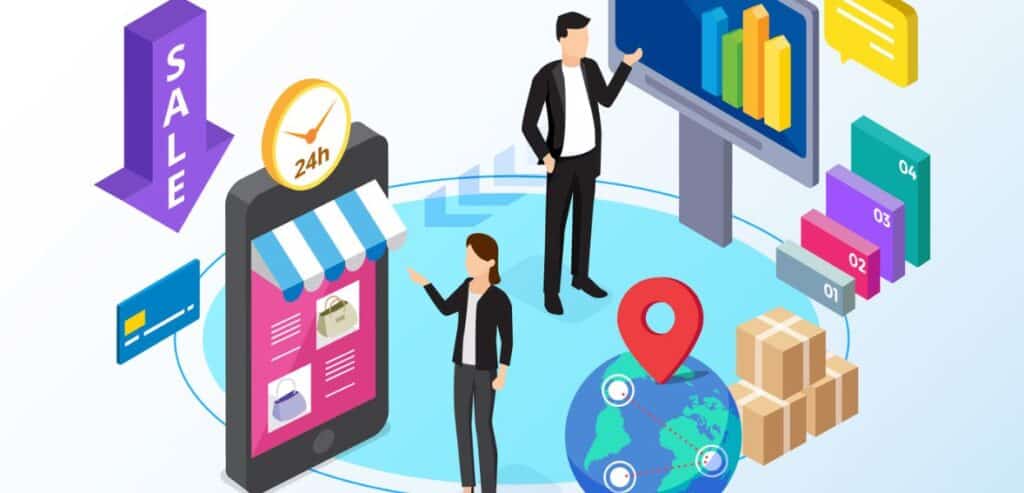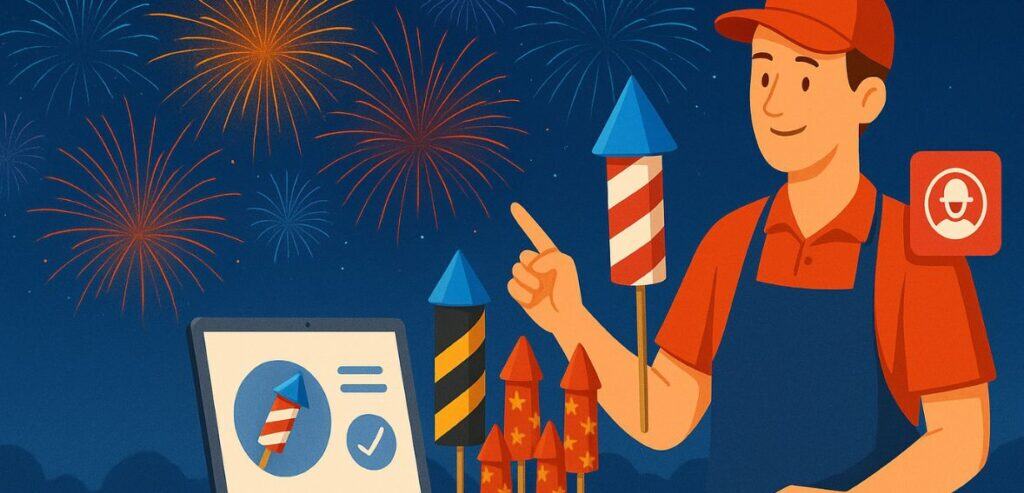
By Shelly Graves June 17, 2025
The business calendar of fireworks retailers is centered around a select few windows of opportunity. The most notable of these are New Year’s Eve and the Fourth of July, two occasions that are known for their spectacular celebrations and pyrotechnics-loving consumers. While there is a great deal of revenue potential during these high-stakes times, there are also substantial operational, marketing, and logistical difficulties.
Retailers of fireworks must put extremely strategic, time-sensitive, and scalable plans into place in order to optimize profits during these critical sales windows. Retailers of fireworks follow a highly seasonal business model, in contrast to other sectors that see steady year-round sales. Major holidays have a short timeline, so careful planning months in advance is essential to success.
Everything needs to go according to plan, from hiring employees and maintaining local compliance to sourcing inventory and marketing initiatives. Because the fireworks sales cycle is so short, there is little opportunity for mistakes and even less time to make adjustments in the middle of the season. In a matter of days or weeks, retailers who can use this limitation to their advantage stand to gain enormous profits.
Forecasting Demand with Precision

Accurate demand forecasting is essential to a successful seasonal strategy. For the majority of retailers, this entails closely examining historical sales data in order to spot trends in consumer preferences, local market conditions, and legislative changes. Local regulations, meteorological conditions, and even sporting events have a significant impact on fireworks sales.
For example, a community with a strong tradition of public celebration and lax fireworks regulations is likely to have higher per capita sales. When planning for peak surges and stocking their shelves, retailers need to consider these external factors.
Strategic Timing and Early Engagement
It’s all about timing. Although the majority of sales take place during the brief period preceding the Fourth of July or New Year’s Eve, customer interest frequently starts weeks earlier. By teasing new inventory or providing temporary discounts to pre-buy or reserve popular items, astute retailers start warming up their audiences with early marketing campaigns.
During this stage, social media, local advertising, and email campaigns are crucial. Retailers can create anticipation and disperse traffic over a few weeks with the correct messaging, which will minimize last-minute chaos and guarantee seamless inventory flow.
Targeted Marketing That Connects with the Community
Using video content that shows product demonstrations, safety procedures, or user-generated content from previous years can provide both education and entertainment. In areas where fireworks laws are strict, focusing on legal alternatives like sparklers or novelty items can keep the customer base engaged while staying compliant. Marketing should not just be early—it must be hyper-targeted.
Fireworks buyers are usually repeat customers who enjoy the ritual and experience at least as much as the product itself. Developing a strong brand identity helps fireworks retailers stand out during crowded holiday seasons and ensures consistent customer recognition across marketing channels.
Optimizing the In-Store Experience

It is necessary to optimize the retail environment for a high-velocity transaction model. Checkout lines, product organization, and staffing levels must be adjusted to handle the rush because most fireworks stores experience exponential spikes in traffic just before the holiday. Efficiency and customer flow must be considered when designing temporary sites, also known as pop-up tents, which are common in many states.
Clear signage, clearly marked categories, and personnel who have received adequate training on safety protocols and product knowledge are all essential. In addition to expediting transactions, this fosters trust, which is essential when marketing risky products.
Modernizing Payment Systems and Sales Infrastructure
In this context, digital payment infrastructure is crucial. Although cash still predominates in some pop-up or rural settings, everyone now expects quick, safe card or mobile payments. Businesses that only use antiquated point-of-sale systems frequently lose sales because of snags or the incapacity to accept contactless payments.
A more seamless experience that directly increases sales and lowers operational friction is achieved by retailers by switching to a modern point-of-sale system that can handle seasonal volume, manage inventory in real-time, and provide digital receipts.
Driving Sales Through Bundling and Product Mix
Bundling is a highly profitable strategy that is often overlooked. Instead of offering individual fireworks for a set price, retailers can package themed assortments that cater to various buyer types, such as kid-friendly kits with lower decibel ratings, show-stopper displays for larger events, or family-safe bundles.
In addition to increasing the average order value, bundles make shopping easier for clients who might be intimidated by the selection. In order to test out new inventory configurations or move older stock without risking standalone performance, retailers can use bundling as a lever.
Navigating Local Regulations and Compliance

Regulatory compliance is another important component. The kinds of fireworks that can be sold, when they can be sold, and under what circumstances are governed by laws that vary from state to state and frequently from municipality to municipality. It takes ongoing attention to detail to stay in compliance, and breaking even a small code can result in penalties, closures, or harm to one’s reputation.
Retailers are required to collaborate closely with local authorities, secure the necessary permits well in advance, and keep thorough records during the selling period. In addition to ensuring transparency, prominently displaying licenses on websites and in-store fosters customer trust.
Inventory Management and Supplier Relationships

Planning an inventory is both an art and a science. Because fireworks are volatile, overstocking causes expensive excess and storage problems. Conversely, understocking leads to lost sales and disgruntled clients. Retailers should look into options for staggered delivery schedules and build relationships with dependable suppliers.
Demand planning should be dynamic, taking into account early sales results and weather predictions to make necessary mid-season inventory adjustments. Having a local distributor or backup supplier on hand can act as a crucial buffer on busy days.
Customer Service That Builds Loyalty
It is impossible to ignore in-store customer service. Even though holiday sales move quickly, every purchase is a chance to win over a repeat customer. Employees should receive training on product features, usage guidelines, and safety precautions. Giving advice boosts customer satisfaction, lowers uncertainty, and frequently results in upsells.
For instance, when properly advised, a buyer interested in a single aerial firework might buy a high-end launcher kit or safety equipment. Promoting discussions about child supervision and safe storage builds the retailer’s reputation and lowers risk for all parties.
Logistics and Real-Time Stock Flow
Efficient logistics and real-time stock flow are critical to capitalizing on the narrow sales windows during peak seasons like the 4th of July and New Year’s Eve. Retailers must not only focus on getting products to store shelves quickly but also on how those products move through internal storage, staging, and final sale. Optimizing distribution channels can dramatically improve delivery accuracy and reduce delays that lead to missed sales opportunities.
By streamlining supplier coordination and internal movement—from warehouse to retail floor—fireworks businesses can ensure that best-selling products are always in stock. Leveraging modern tools like mobile scanning, barcoding, and inventory apps allows teams to adjust in real time and reduce shrinkage, ultimately improving both customer satisfaction and profit margins.
Beyond the Boom: Expanding Your Seasonal Sales Strategy for Fireworks Retailers Year-Round

Retail fireworks sales can be both thrilling and difficult, particularly during the constrained timeframes of July 4th and New Year’s Eve. These holidays are the result of months of planning and are more than just hectic sales days. However, success doesn’t stop at the cash register for companies that sell fireworks and want to increase profits and create sustainability.
Long-term growth in today’s market depends on incorporating robust e-commerce support, prioritizing safety, increasing off-season relevance, and carrying out strategic post-season analysis.
Digital Sales and Online Support That Mirrors the In-Store Experience
Having a digital presence is now essential for contemporary fireworks retailers, not just a benefit. Fireworks vendors must make sure their websites provide the same level of customer service that customers expect in-store as more and more customers use online platforms for convenience and pre-purchase research.
The first step is an easy-to-use e-commerce interface that displays the entire inventory, including pictures, product details, and obvious indications of local legality. This can give you a competitive advantage in areas that are regulated. Retailers can decrease confusion and increase confidence by letting customers search products using their zip code and legality filters. Customers have more options when pre-ordering with in-store pickup is available, and businesses can better control traffic and inventory on busy days.
Online videos that highlight the effects of products, comparison tools, or brief safety clips can also significantly increase user engagement. Before they ever set foot in the store, these resources transform online shoppers into knowledgeable, content customers by fostering a sense of transparency and offering vital education. Retailers can increase their revenue and operational efficiency by embracing omnichannel sales to the fullest.
Overselling can be avoided and real-time stock accuracy can be guaranteed by integrating inventory management systems with the online store. Reliability benefits customers while saving the company money on labor costs associated with handling complaints and order corrections. Growing tech-savvy consumers need fireworks vendors to meet them where they are—on their phones and laptops—with flawless, consistent shopping tools.
Safety as a Sales Strategy, Not Just a Legal Requirement
Encouraging safety is a chance to increase brand trust and generate more income in addition to meeting legal requirements. Because of their nature, fireworks need to be used with caution. Retailers who set the standard for transparency and education portray themselves as ethical, community-focused companies.
The store’s professional image can be enhanced by small additions like looping safety demonstration videos close to checkout, printed safety checklists, or display signage with appropriate usage instructions. Providing firework safety kits, which may include gloves, goggles, or extinguishers, increases the potential for upselling and offers value-added options at the point of sale.
Here, staff training is essential. Credibility is increased when staff members are able to confidently explain how to use products safely, make recommendations for suitable options for family-friendly settings, or steer customers away from inappropriate combinations. Safety advocacy can become a loyalty driver as customers who feel taken care of are more likely to return and refer others to the store.
Social media campaigns that focus on community safety, like advice for pet owners, safe cleanup techniques, or legal updates, can also generate significant engagement and position your company as a reliable authority outside of the transactional moment.
Reflecting for Results: The Power of Post-Season Analysis
The post-holiday review is the last and frequently overlooked component of a successful strategy. It’s time for businesses to analyze the data and determine what worked and what didn’t after the crowds have subsided and the fireworks have faded. The goal of this process is to use insights to create a more intelligent, well-run business, not just to find excess inventory or calculate sales.
Which products were sold out too quickly? Which bundles stayed on the shelves for too long? Which inquiries were most common among customers? These trends point to weaknesses in product education, merchandising strategy, or forecasting. Businesses gain the insight they need to optimize for the upcoming year by reviewing team performance, customer feedback, and even marketing metrics.
Additionally, a well-executed post-mortem prepares the ground for the upcoming preseason. Months in advance, VIP discounts or first looks at new inventory can be introduced using contact lists of happy customers. Holiday footage can be used to create social media content that can be used for future marketing campaigns. In essence, the work completed following the sale serves as the foundation for the subsequent successful campaign.
Conclusion: Turning Celebration into Strategy
In summary, selling fireworks involves more than just keeping inventory on hand and waiting for clients to show up. It’s a complex, intricate business that needs agility, foresight, and a customer-first mentality. Every element affects overall profitability, from marketing timing and digital readiness to safety training and regulatory compliance.
Because the fireworks season is so short, every choice has greater significance, and those who make thoughtful plans will benefit. New Year’s Eve and the Fourth of July are more than just dates on the calendar; they are the result of community bonding, operational coordination, and strategic effort.
Retailers can seize chances for both long-term brand loyalty and explosive profits by treating these seasons as campaigns rather than just sales windows. In a company that is centered around celebrations, those who are able at the little things will continue to be successful long after the last fireworks have gone out.
